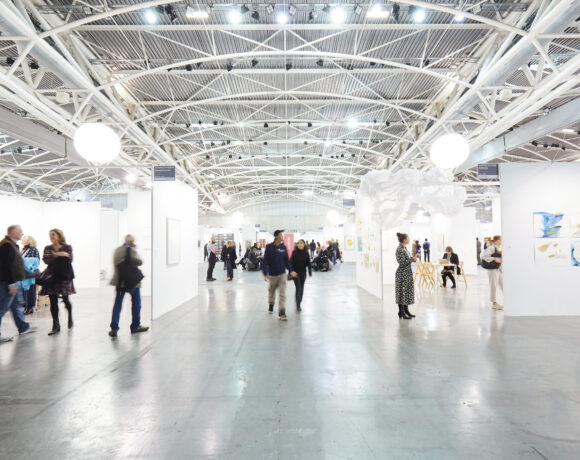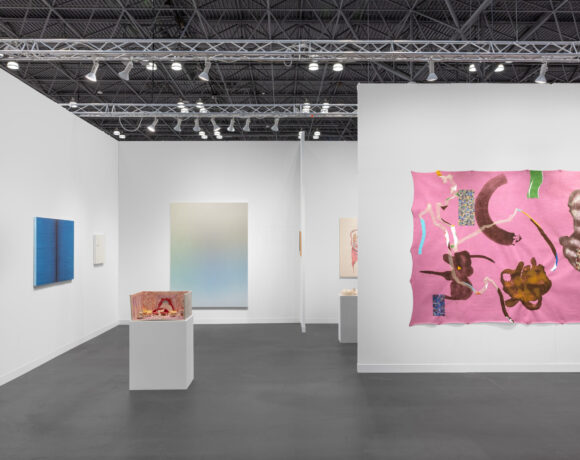The 24th edition of the most important Italian contemporary art fair starts today in Turin under the direction of Ilaria Bonacossa, which last December replaced Sarah Cosulich, who had leaded the event for 5 consecutive years. Artissima will be held from 3 to 5 November at the Oval glass pavilion built for the Winter Olympics, and it will bring together 206 galleries featuring the works of 700 artists from 32 different nationalities with the aim of comparing established and emerging realities joint by a similar curatorial vocation according to the experimental identity that has always characterized the fair. In addition to the main sections, i.e. the Main Section, dedicated to the most established galleries in the international scene, Dialogue, reserved for emerging galleries or galleries with an experimental approach featuring a monographic stand or the works of 2-3 artists in dialogue, New Entries, for galleries which have been active for less than five years and for the first time in Turin and Art Editions, for galleries specialized in editions and multiples by artists, there are three more. Present Future valorize emerging talents selected by a committee of young international curators, Back to the Future analyzes the pioneering aspects of the historic art scene that focuses on this edition in the 1980s; Drawings focuses on the peculiarities of this expressive medium in balance between the idea and the finished work. In the multifaceted exhibition offer presented by the galleries we have tried to identify some paradigmatic artistic trends in the contemporary landscape, which we follow below without any pretense of exhaustiveness along with some indications of what we believe to be seen.
One of the first interesting points to note is the high concentration of artists engaged in the recovery (firsthand or by delegation) of craftsmanship techniques once linked to a purely feminine and domestic sphere, such as embroidery, weaving and crochet, which are reworked in a conceptual, pictorial, commemorative, documentary or narrative key. Among these there are wool rugs woven from quick notes and reminders that Christian Jankowski (Galleria Enrico Astuni) uses to organize the voyages of his nomadic life, the quilt-shroud in various vermilion gradations with which Abdoulaye Konaté (Galleria Primo Marella) denounces the violence of the war in Syria or the elegant ritual wreaths woven with gold leaf and magic stones realized by Summer Wheat (Braverman Gallery). Precious embroidered inserts transform the portraits of Francesco Vezzoli (Franco Noero Gallery) into damn soul icons, while Maria Arendt (Galerie Iragui) documents the constructivist projects of the 1920s on a series of embroidered cloths that confuse existing modernist monuments and never realized utopias. For Jöel Andrianomearisoa (Sabrina Amrani), tissues may have emotional value when they retain the traces of those who possessed or worked them, or become as mobile and impalpable chromatic substance as a transient mood in his vertical rugs made of waste textile processing. Fabrics can become artistic material even without their utilitarian nature being modified by specific interventions, as is the case of Simon Callery’s sculptures (Fold Gallery) formed by the fall of loose folds of rigid fabrics folded on themselves or the elusive installations in which Jason Dodge (Franco Noero Gallery) makes people around the world weave a strip of night color cloth which is of the same length of the distance separating the earth and meteorological phenomena. Halfway between sculpture and enigmatic poetry the floral patterns Ian Law (Rodeo Gallery) carves in the spoonful of seats taken from the waiting room of a hospital in The wait is over, while Paolo Lobato (Bendana | Pinel) finds an imperceptible and rarefied source of charm in the presentation of traditional Korean fabric strips cut off without precision by local sellers. Art, of course, has its own internal reasons and unit of measure, but that does not mean that its logic is not effective in helping us understand reality, as is the case of the ironic installation by Cristina Garrido (Curro Gallery) which compares with scientific empiricism the proportion between text and advertising pages on some important contemporary art magazines using stones of different sizes.
If the colorful and joyful modularity of industrial production objects intrigues artists in an extreme legacy of pop culture, as in the complementary accumulation of Laura Ramis (Galería Rafael Pérez Hernando), the sculpture on display seems to reveal an ambiguous relationship between imitation and dissimulation with the most ordinary elements of everyday life. Thus bronze imitates waste cardboard in Mario’s García Torres Against Permanence (Galleria Franco Noero), Giulia Cenci (SpazioA) uses her most sophisticated camouflage skills to reproduce unnecessary remains of imaginary works or pseudo natural wrecks, Belén Uriel (Madragoa ) models with poor materials sculptures that at first sight would seem simple ready made, while John Termini (Otto Gallery) works on the boundary between minimal assembly, formal fluidity and logical contradictions. Silently, some objects that are taken as a model for sculptures or are made up of raw materials seem to want to claim their own biological dignity, as it happens in the works of Martino Genchi (Galleria Michela Rizzo), nude structures made up of contrasting tensions in secret opposition to all sculptural immobility, in porous meltings by Alberto Scodro (CAR drde) ready to incorporate in themselves any chemical element of the surrounding reality or in the ambiguous combinations between artificial matter and materials of animal origin made by Mimosa Echard (Galerie Sami Abraham).
Even the painting, which in its more traditional manifestations ranges between a visceralism that comes from a far memory of Bacon, a caricaturist Bosch’s monstrosity or monochromatic explorations of all the possible shades of texture and brushstroke, seems to want to force its consolidated boundaries to venture on a insidious terrain that leads to the emulation / sophistication of visual archetypes usually associated with other disciplines. Thus, for example, Paolo Bini’s stratifications (Alberto Peola Arte Contemporanea) seem to allude to the compression and defragmentation of cryptic mental files, while the gestural still life of Edwin Burdis (Vitrine) show gaps that look like magnifications of corrupt pixels. Painting has always been trying to engage the third dimension, but now it seems disinterested in the classic illusion of depth to chase a sculptural imprint, as is the case with the Pennacchio Argenato (Acappella) metal sheets that mimic the folds and nuances of refined colored papers or the overlapping of pictorial, material and transparent plans by Will Stuart (Clima Gallery). To conclude, there are also those who, perhaps in line with the dematerialization of the global and digital society of our time, bravely present their work as a minimal intervention on the boundary with nothing like the residual installation of Alvaro Urbano (ChertLüdde) composed of tubes and ground papers, or the volatile sculpture by Brookhart Jonquil, which is born from a thin sheet of paper over and over wrinkled and unfolded (Piero Atchugarry).
Info:
Artissima 2017
2017 November, 3 – 5
Oval, Lingotto Fiere Torino
 Simon Callery, Wallspine Green and Black, 2013, canvas, distemper, thread and steel brackets, 88 x 130 x 30 cm, courtesy Fold Gallery
Simon Callery, Wallspine Green and Black, 2013, canvas, distemper, thread and steel brackets, 88 x 130 x 30 cm, courtesy Fold Gallery
 Summer Wheat, Brushing and Snacking, 2016, gold leaf, magic sculpt, resin and acrilyc paint, piece unique, courtesy Braverman Gallery
Summer Wheat, Brushing and Snacking, 2016, gold leaf, magic sculpt, resin and acrilyc paint, piece unique, courtesy Braverman Gallery
 Laura Ramis, Cromática, 2017, Plastic objects , 300×600 cm, courtesy Galería Rafael Pérez Hernando
Laura Ramis, Cromática, 2017, Plastic objects , 300×600 cm, courtesy Galería Rafael Pérez Hernando
 Mimosa Echard, Ballard, car light, pterocera, 2015, courtesy Galerie Sami Abraham
Mimosa Echard, Ballard, car light, pterocera, 2015, courtesy Galerie Sami Abraham
 Alberto Scodro, Untitled (Sunflower), 2017, Glass, sand, zinc, cooper, iron, pigment, oxid, epoxy, cotton, 37×31 cm, Courtesy The Artist & CAR DRDE Bologna
Alberto Scodro, Untitled (Sunflower), 2017, Glass, sand, zinc, cooper, iron, pigment, oxid, epoxy, cotton, 37×31 cm, Courtesy The Artist & CAR DRDE Bologna
 Cristina Garrido, An Unholy Alliance Series, object- art magazine, glue, courtesy Cristina Garrido & Curro Gallery
Cristina Garrido, An Unholy Alliance Series, object- art magazine, glue, courtesy Cristina Garrido & Curro Gallery
 Edwin Burdis, Llanwenarth Breast 1, 2017, Plywood Panel, Spraypaint, Oil and Acrylic. Audio. 41x31x5 cm Courtesy VITRINE
Edwin Burdis, Llanwenarth Breast 1, 2017, Plywood Panel, Spraypaint, Oil and Acrylic. Audio. 41x31x5 cm Courtesy VITRINE
Graduated in art history at DAMS in Bologna, city where she continued to live and work, she specialized in Siena with Enrico Crispolti. Curious and attentive to the becoming of the contemporary, she believes in the power of art to make life more interesting and she loves to explore its latest trends through dialogue with artists, curators and gallery owners. She considers writing a form of reasoning and analysis that reconstructs the connection between the artist’s creative path and the surrounding context.







NO COMMENT